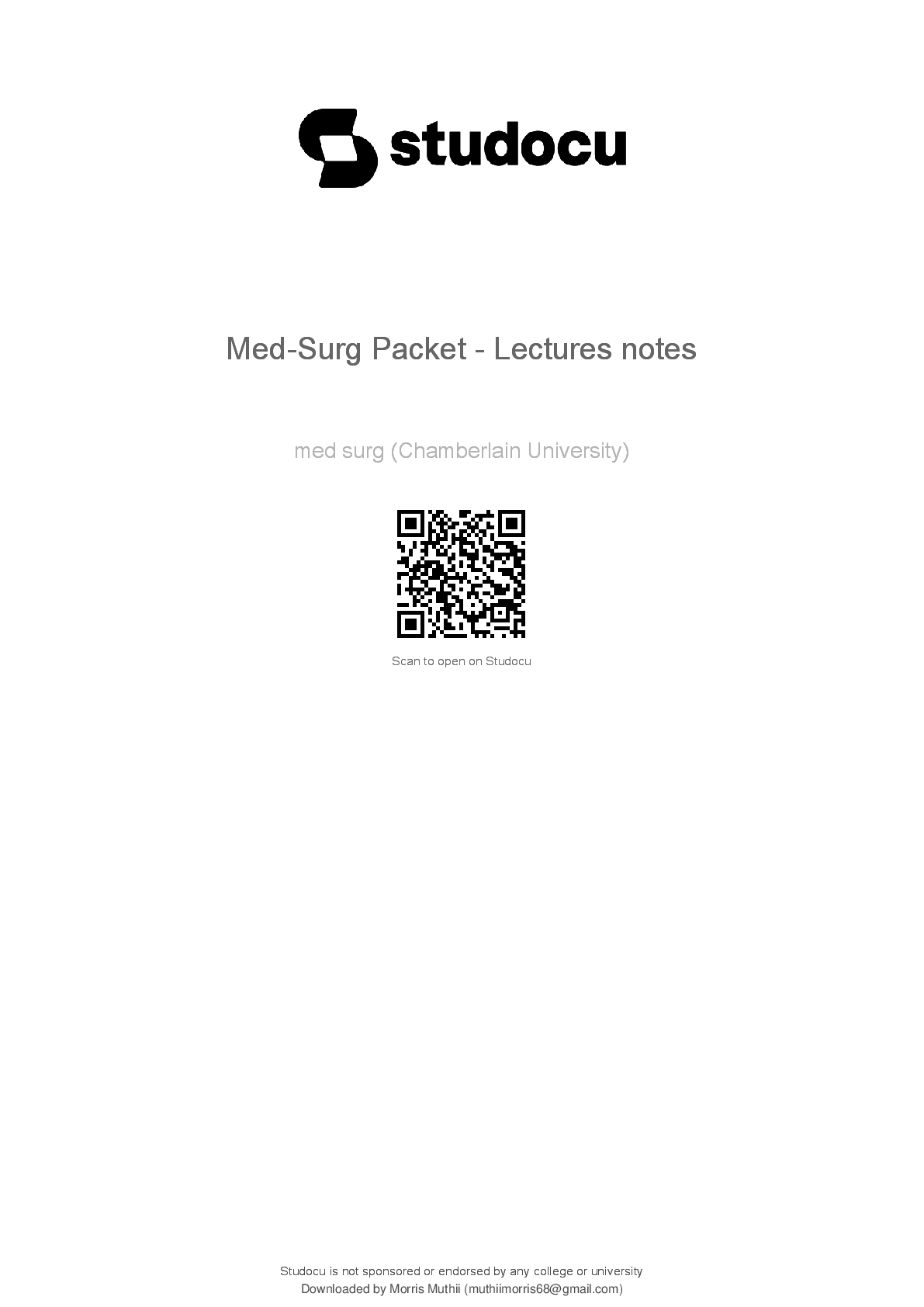Neuroscience > LECTURE SLIDES/NOTES > Purve Neuroscience - Chapter Notes (All)
Purve Neuroscience - Chapter Notes
Document Content and Description Below
Neuroscience Ch.1 Introduction Neurons Dendrites The number of inputs that a particular neuron receives depends on the complexity of its dendritic arbor o The number of inputs to a singl... e neuron reflects the degree of convergence o The number of targets innervated to any one neuron represents its divergence The presynaptic terminal is immediately adjacent to postsynaptic specialization of the target cell Pre- and postsynaptic components communicate via secretion of molecules from presynaptic terminal that bind to receptors in the postsynaptic specialization through the synaptic cleft (site of extracellular proteins that influence the diffusion, binding, and degradation of molecules secreted by the presynaptic terminal) Axons Specialized for relaying electrical signals; “reads” the information conveyed by synapses on the dendrites Many types of axons o Relatively short axons = local circuit neurons (interneuron), found throughout the brain o Axons of projection neurons extend to distant targets (ex. axons from spinal cord to foot) Uses action potentials that propagates from its point of initiation (axon hillock) to the terminus of the axon, at which point synaptic contacts are made Synaptic Transmission Chemical and electrical process by which the information encoded by action potentials is passed on at synaptic contacts to the next cell in a pathway Presynaptic terminals (axon terminals) and their postsynaptic specializations are typically chemical synapses – the most abundant type of synapse in the NS Electrical synapses (facilitated by the gap junctions) are more rare Synaptic vesicles – spherical structures filled with NT molecules The positioning of synaptic vesicles at the presynatpic membrane and their fusion to initiate NT release is regulated by a number of proteins w/in or associated with the vesicle The NT released from synaptic vesicles modify the electrical properties of the target cell by binding to NT receptors localized primarily at the postsynaptic specialization The intricate and concerted activity of NT, receptors, related cytoskeletal elements, and signal transduction molecules are the basis for nerve cells communicated with one another, and with effector cells in muscles and glands Neuroglial Cells Glial Cells Neuroglial cells are more numerous than neurons in the brain (3:1), but don’t’ participate directly in synaptic interactions and electrical signaling But, their supportive functions help define synaptic contacts and maintain the signaling abilities of neurons Roles Maintaining the ionic milieu of nerve cells Modulating the rate of nerve signal propagation Modulating synaptic action by controlling the uptake of NT at or near the synaptic cleft Providing a scaffold for some aspects of neural development Aiding (or in some instances impeding) recovery from neural injury Types of Glial Cells Astrocytes o Restricted to the CNS (ie brain and spinal cord) o Have elaborate local processes that give these cells a star like appearance Downloaded by Morris Muthii (muthiimorris68@gmail.com) Neuroscience Ch.1 o Maintain an appropriate chemical environment for neuronal signaling o A subset of astrocytes in the adult brain may retain the characteristics of neural stem cells (capacity to enter mitosis and generate all of the cell classes found in the nervous tissue) Oligodendrocytes o Also restricted to the CNS o Lay down a laminated, lipid-rich wrapping called myelin around some axons Myelin has important effect on the speed of the transmission of electrical signals In the PNS, the cells that elaborate myelin are Schwann cells Microglial cells o Derived primarily from hematopoietic precursor cells o Share many properties with macrophages and are primarily scavenger cells that remove cellular debris from sites of injury or normal cell turnover o Also secrete signaling molecules (like their macrophage counterparts) – particularly a wide range of cytokines that are also produced by cells of the immune system – that can modulate local inflammation and influence cell survival or death Cellular Diversity in the Nervous System The cellular diversity of any NS underlies the capacity of the system to form increasingly complicated networks and to mediate increasingly sophisticated behaviors Can use fluorescent dyes and other soluble molecules injected into single neurons to visualize individual nerve cells and their processes Other stains are used to demonstrate the distribution of all cell bodies – but not their processes or connections – in neural tissue o Demonstrate that the size, density, and distribution of the total population of nerve cells is not uniform form region to region within the brain o In some regions, such as the cerebral cortex, cells are arranged in layers and each layer has difference cell density Neural Circuits Neural circuits – process specific kinds of info and provide the foundation of sensation, perception, and behavior The synaptic connections that define neural circuits are typically made in a dense tangle of dendrites, axon terminals, and glial cell processes that together constitute what is called neuropil The neuropil = region b/w nerve cell bodies where most synaptic connectivity occurs Basic constituents of neural circuits Afferent neurons – carry information from periphery toward the brain or spinal cord Efferent neurons – carry information away from the brain or spinal cord (away from the circuit) Interneuron – local circuit neurons, only participate in the local aspects of a circuit, based on the short distances over which their axons extend Myotatic Spinal Reflex “Knee-jerk” reflex Extracellular recordings – detect action poentials, usefully for detecing tempeoral patterns of action potential activity and relating those patterns to stimulation by othe inputs or to speciif behavioral events Intracellular recordings – detect the smaller, graded potential changes that trigger action potentials, and thus allow a more detailed analysis of communicaton between neurons within a cirut These graded triggering potentials can arise at either sensory receprs or synapses and are called receptor potentials or synaptic potentials, respectively Downloaded by Morris Muthii (muthiimorris68@gmail.com) Neuroscience Ch.2 Electrical Signals of Nerve Cells Electrical Potentials across Nerve Cell Membranes Resting membrane potential (-40 to -90 mV) Receptor potentials – from the activation of sensory neurons by external stimuli such as light, sound, or heat o Ex. touching skin activates Pacinian corpuscles, receptor neurons that sense mechanical disturbances of the skin o Amplitudes are graded in proportion to the magnitude of the sensory stimulus Synaptic Potentials – allows transmission of information from one neuron to another Using electrical signals presents problems in electrical engineering o A fundamental problem for neurons is that their axons, which can be quite long are not good electrical conductors o To compensate for this deficiency, neurons have evolved a “booster system” that allows them to conduct electrical signals over great distances despite their intrinsically poor electrical character – action potentials Action potentials – active response generated by neuron, when a brief change from negative to positive occurs in the transmembrane potential. o One way to elicit an action potential is to pass an electrical current across the neuron membrane Current normally generated by receptor potentials or by synaptic potentials. In the lab, electrical current is produced by inserting a second microelectrode into the same neuron and then connecting the electrode to a battery o Amplitude of the action potential is independent of the magnitude of the current All-or-none o Hyperpolarization – if current delivered makes membrane potential more negative Nothing drastic happens; don’t require any unique property of neurons and are therefore called passive electrical responses o Depolarization – if current of the opposite polarity is delivered, so that the membrane potential of the nerve cell becomes more positive than the resting potential In this case, at certain level of membrane potential, called threshold potential, and action potential occurs How Ionic Movements Produce Electrical Signals Electrical potentials are generated across the membranes of neurons because… o There are differences in the concentrations of specific ions across nerve cell membranes o The membranes are selectively permeable to some of these ions Active transporters – the ion concentration gradients are established by these proteins o Actively move ions into or out of cells against concentration gradients Ion channels – only allows certain kinds of ions to cross the membrane in the direction of their gradient Electrochemical equilibrium – there is an exact balance between two opposing forces: (1) the concentration gradient that causes ion (K+) to move from compartment 1 to compartment 2, taking along positive charge, and (2) an opposing electrical gradient that increasingly tends to stop K+ from moving across the membrane o The number of ions that needs to flow to generate this electrical potential is very small (~ 10-12 moles of K+ per cm2 of membrane) Means that the concentrations of permeant ions on each side of the membrane remain essentially constant, even after the flow of ions has generated the potential And the tiny fluxes of ions required to establish the membrane potential don’t disrupt chemical electro-neutrality because each ion has an oppositely charged counter-ion The Forces that Create Membrane Potentials Equilibrium potential – electrical potential generated across the membrane at electrochemical equilibrium Nernst equation = Equilibrium potential for any ion X Downloaded by Morris Muthii (muthiimorris68@gmail.com) Neuroscience Ch.2 o R=gas constant; T=absolute temperature (K); z=valence (electrical charge) of permeating ion; F=Faraaday constant (amount of electrical charge contained in one mole of a univalent ion) When the concentration of K+ is higher inside than outside, an inside-negative potential is measured across the K+ permeable neuronal membrane The balance of chemical and electrical forces at equilibrium means that the electrical potential can determine ion fluxes across the membrane, just as the ionic gradient can determine the membrane potential. Electrochemical Equilibrium in an Environment with More than One Permeating Ion Goldman’s Equation: o V = the voltage across the membrane; P = permeability of the membrane to each ion of interest o Extended version of the Nernst equation that takes into account the relative permeability of each of the ions involved The Ionic Basis of the Resting Membrane Potential Action of ion transporters creates substantial transmembrane gradients for most ions o There’s much more K+ inside the neuron than outside, and much more Na+ outside than inside o These transporter-dependent concentration gradients are, indirectly, the source of the resting neuronal membrane potential and the action potential Hodgkin and Katz Experiment: o Assuming that the internal K+ concentration is unchanged during the experiment, a plot of membrane potential vs. log(external K+ concentration) = straight line with slope of 58 mV per tenfold change in external K+ concentration at room temperature Value not exactly 58 mV because other ions are also slightly permeable (Cl-, Na+) o Showed that the inside-negative resting potential arises because The membrane of the resting neuron is more permeable to K+ than other ions There is more K+ inside the neuron than outside The selective permeability to K+ is caused by K+-permeable membrane channel that are open in resting neurons and the large K+ concentration gradients is produced by membrane transporters that selectively accumulate K+ within neurons The Ionic Basis of Action Potentials If the membrane were to become highly permeable to Na+, the membrane potential would approach ENA Hodgkin and Katz tested the role of Na+ in generating the action potential by asking what happens tot eh action potential when Na+ is removed from the external medium o Found that lowering Na+ concentration reduces both the rate of rise of the action potential and its peak amplitude While the resting neuronal membrane is only slightly permeable to Na+, the membrane becomes extraordinarily permeable o Na+ during the rising phase and overshoot phase of the action potential o But very brief because increased membrane permeability to Na+ is very short-lived o Membrane potential rapidly repolarizes to resting levels and is followed by undershoot o During undershoot, the membrane potentials is transiently hyperpolarized because K+ permeability becomes even greater than at rest The ion substitution experiments carried out by Hodgkin and Katz showed that the resting membrane potential results from a high resting membrane permeability to K+, and that depolarization during an action potential results from a transient rise in membrane Na+ permeability o But they did not establish how the neuronal membrane is able to change its ionic permeability to generate action potential, or what mechanisms trigger this critical change Downloaded by Morris Muthii (muthiimorris68@gmail.com) Neuroscience Ch.3 Voltage-Dependent Membrane Permeability Introduction For most type of axons, the changes in membrane potential consist of a rapid and transient rise in sodium ion permeability, followed by a slower but more prolonged rise in permeability to potassium ions o Both permeabilities are voltage-dependent, increasing as the membrane potential depolarizes Ionic Currents Across Nerve Cell Membranes Voltage clamp method = provides information needed to define the ionic permeability of the membrane at any level of membrane potential o Holds the membrane potential at a set point 1. Measures the membrane potential with a microelectrode placed inside the cell 2. Electronically compares this voltage to the voltage to be maintained (called the comma [Show More]
Last updated: 2 months ago
Preview 1 out of 20 pages

Loading document previews ...
Buy this document to get the full access instantly
Instant Download Access after purchase
Buy NowInstant download
We Accept:

Reviews( 0 )
$10.50
Can't find what you want? Try our AI powered Search
Document information
Connected school, study & course
About the document
Uploaded On
Mar 19, 2025
Number of pages
20
Written in
Additional information
This document has been written for:
Uploaded
Mar 19, 2025
Downloads
0
Views
15








